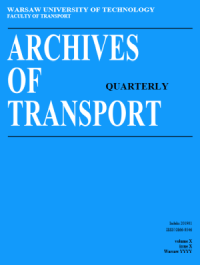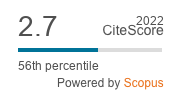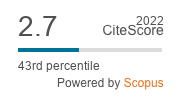A new simulation-optimization approach for the circulation facilities design at urban rail transit station
DOI:
https://doi.org/10.5604/01.3001.0010.1795Keywords:
urban rail transit station, facilities design, genetic algorithm, simulation optimisationAbstract
Width design of the urban rail transit stations circulation facilities is a vital issue. The existing width design approach failed in fully considering the essential factors such as fluctuation in passengers’ arrival process, fluctuation and state-dependence in passengers walking speed and the blocking when passengers’ demand exceeds the capacity of facilities. For this purpose, a PH-based simulation-optimization approach is proposed that fully considers the fluctuation, the state-dependence, Level of Service (LOS) and blocking effect. This novel approach provides automatic reconfiguration of the widths of circulation facilities by a concurrent implementation of a PH-based Discrete-Event Simulation (DES) model and the Genetic Algorithm (GA). The proposed PH-based simulation-optimization approach and the existing design approaches based on the exponential and deterministic models are applied to design the widths of circulation facilities. The results reveal that the circulation facilities designed by the proposed approach have larger widths. Similarly, increase in the SCV of arrival interval results in increasing the widths designed by the proposed approach increase while the widths of the other two approaches stay the same. The width designed of the proposed approach increase at faster rate than that of the other two approach when the passengers’ arrival rate increases.
References
ALFA, A. S., and ZHAO, Y. Q., 2000. Overload analysis of the PH/PH/1/K queue and the queue of M/G/1/K type with very large K. Asian Pacific Journal of Operational Research, 17, 122-136.
BANKS, J. (2010). Discrete-event System Simulation, Prentice Hall.
CASSANDRAS, C. G., & LAFORTUNE, S., 2009. Introduction to Discrete Event Systems: Springer US.
CHEAH, J., and SMITH, J. M., 1994. Generalized M/G/C/C state dependent queueing models and pedestrian traffic flows. Queueing System, 15(1-4), 365-386.
CHEN, S. K., and S. Liu, XIAOM,X., 2012. M/G/C/C-based Model of Passenger Evacuation Capacity of Stairs and Corridors in Urban Rail Transit Station. Journal of China Railway Society, 34, 7-12.
CRUZ, F. R. B., MACGREGOR SMITH, J., AND MEDEIROS, R. O., 2005. An M/G/C/C state-dependent network simulation model. Computers & Operations Research, 32(4), 919-941.
CRUZ, F. R. B., SMITH, J. M., AND QUEIROZ, D. C., 2005. Service and capacity allocation in M/G/C/C state-dependent queueing networks. Computers & Operations Research, 32(6), 1545-1563.
FIGUEIRA G, ALMADA-LOBO B., 2014. Hybrid simulation–optimization methods: A taxonomy and discussion[J]. Simulation Modelling Practice and Theory, 46, 118-134.
FU, M. C., 2002. Feature Article: Optimization for simulation: Theory vs. Practice. INFORMS Journal on Computing, 14(3), 192-215.
HAGENDORF, O., PAWLETTA, T. and LAREK, R., 2013. An approach for simulation-based parameter and structure optimization of MATLAB/Simulink models using evolutionary algorithms. SIMULATION.
HASSANNAYEBI E, SAJEDINEJAD A, MARDANI S., 2014. Urban rail transit planning using a two-stage simulation-based optimization approach. Simulation Modelling Practice and Theory, 49, 151-166.
HU, L., JIANG, Y., ZHU, J., and CHEN, Y., 2015. A PH/PH state-dependent queuing model for metro station corridor width design. European Journal of Operational Research, 240(1), 109-126.
HUBSCHER-YOUNGER, T., MOSTERMAN, P. J., DELAND, S., ORQUEDA, O., and EASTMAN, D., 2012. Integrating discrete-event and time-based models with optimization for resource allocation. Proc., Simulation Conference (WSC), Proceedings of the 2012 Winter, 1-15.
JACYNA, M., WASIAK, M., LEWCZUK, K., KŁODAWSKI, M., 2015. Simulation model of transport system of poland as a tool for developing sustainable transport. The Archives of Transport, 31(3), 23-35.
JIANG, Y., and LIN, X., 2013. Simulation and Optimization of the Ticket Vending Machine Configuration in Metro Stations Based on Anylogic Software. Fourth International Conference on Transportation Engineering, 754-760.
JIANG, Y., HU, L., and LU, G., 2010. Determined method of subway footway width based on queuing theory. Journal of Traffic and Transportation Engineering, 10, 61-67.
JIANG, Y., HU, L., ZHU, J., and CHEN, Y., 2013. PH fitting of the arrival interval distribution of the passenger flow on urban rail transit stations. Applied Mathematics and Computation, 225, 158-170.
JIANG, Y., ZHU, J., HU, L., LIN, X., and KHATTAK, A., 2016. A G/G(n)/C/C state-dependent simulation model for metro station corridor width design. Journal of Advanced Transportation, 50, 273–295.
KAAKAI F, HAYAT S, EL MOUDNI A., 2007. A hybrid Petri nets-based simulation model for evaluating the design of railway transit stations. Simulation Modelling Practice and Theory, 15(8), 935-969.
KHALID, R., M. NAWAWI, M. K., KAWSAR, L. A., GHANI, N. A., KAMIL, A. A., and MUSTAFA, A., 2013. A Discrete Event Simulation Model for Evaluating the Performances of an M/G/C/C State Dependent Queuing System. PLoS ONE, 8(4), e58402.
KITTELSON, Associates, Administration, U. S. F. T., Program, T. C. R., Corporation, T. D., and Board, N. R. C. T. R., 2003. Transit Capacity and Quality of Service Manual, Transportation Research Board of the National Academies.
KRISHNAMOORTHY, A., BABU, S., and NARAYANAN, V. C., 2008. MAP/(PH/PH)/c Queue with Self-Generation of Priorities and Non-Preemptive Service. Stochastic Analysis and Applications, 26(6), 1250-1266.
LEWCZUK, K., 2015. The concept of genetic programming in organizing internal transport processes. Archives of Transport, 34(2), 61-74.
LØVÅS, G. G., 1994. Modeling and simulation of pedestrian traffic flow. Transportation Research Part B: Methodological, 28(6), 429-443.
SMITH, J. M. G., 1991. State-dependent queueing models in emergency evacuation networks. Transportation Research Part B: Methodological, 25(6), 373-389.
MESSAC, A., 2015. Optimization in Practice with MATLAB, Cambridge University Press.
MITCHELL, D. H., and MACGREGOR SMITH, J., 2001. Topological network design of pedestrian networks. Transportation Research Part B: Methodological, 35(2), 107-135.
MIYAZAWA, M., SAKUMA, Y., & YAMAGUCHI, S., 2007. Asymptotic Behaviors of the Loss Probability for a Finite Buffer Queue with QBD Structure. Stochastic Models, 23(1), 79-95.
NEUTS, M. F., 1981. Matrix-geometric Solutions in Stochastic Models: An Algorithmic Approach, Dover Publications.
SADRE, R., 2007. Decomposition-based analysis of queueing networks. University of Twente, Twente.
SADRE, R., and HAVERKORT, B., 2011. Decomposition-Based Queueing Network Analysis with FiFiQueues. Queueing Networks, R. J. Boucherie, and N. M. van Dijk, eds., Springer US, 643-699.
SWISHER, J. R., HYDEN, P. D., JACOBSON, S. H., and SCHRUBEN, L. W., 2000. Simulation optimization: a survey of simulation optimization techniques and procedures. Proceedings of the 32nd conference on Winter simulation, Society for Computer Simulation International, Orlando, Florida, 119-128.
TEKNOMO, K., 2006 Application of microscopic pedestrian simulation model. Transportation Research Part F: Traffic Psychology and Behaviour, 9(1), 15-27.
TREGENZA, P., 1976. The design of interior circulation, Van Nostrand Reinhold.
XU, X.., LIU, J., LI, H., AND HU, J., 2014. Analysis of subway station capacity with the use of queueing theory. Transportation Research Part C: Emerging Technologies, 38, 28-43.
YUHASKI, S. J., and SMITH, J. M., 1989. Modeling circulation systems in buildings using state dependent queueing models. Queueing Systems, 4(4), 319-338.
Downloads
Published
Issue
Section
License
Copyright (c) 2024 Archives of Transport journal allows the author(s) to hold the copyright without restrictions.

This work is licensed under a Creative Commons Attribution 4.0 International License.











